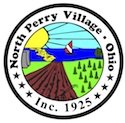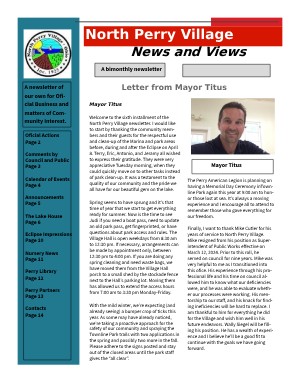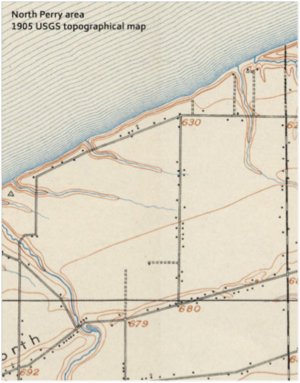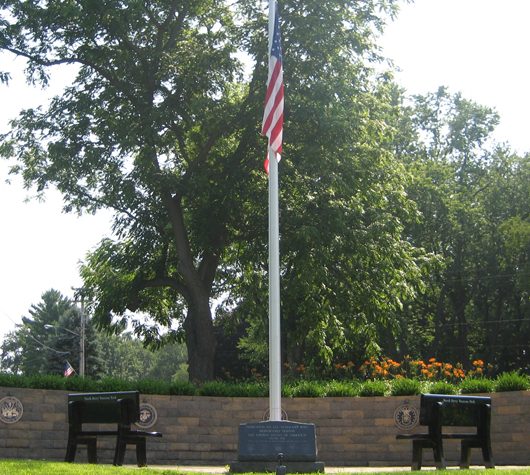During the French and Indian War, (1756-1763), the French built many forts along the coastlines of the Great Lakes. The British, in their efforts to take control of the Great Lakes, used their ships to attack the French coastal forts and the encampments of their Indian allies. Several British cannon balls from these attacks have been found in North Perry Village.
After the American Revolution, land in this area was organized into the Northwest Territory, set aside for veterans and their families. In 1805, shortly after Ohio became a state, the State Legislature created Geauga County which included Plymouth Township. In 1815, Plymouth Township was divided into Painesville and Perry Townships. Perry Township was named to honor Oliver Hazard Perry, hero of the battle of Lake Erie. In 1840, Lake County was formed out of six townships from Geauga County and one from Cuyahoga County. Perry Township was one of the six former Geauga County townships.
The area that is now the Village of North Perry was and is part of Perry Township, formerly the Connecticut Western Reserve area. One of the earliest settlers was Eleazar Parmly and his wife Hanna Spear. They traveled here from Vermont to establish a pioneer home in 1817. Their two married daughters preceded them. The first, Hanna Burridge arrived in 1814 and was followed by Betsey Hurlbert in 1816.
Eleazar and Hanna had four sons that became prominent dentists. One son, Jahial Parmly built `The Mansion` in 1834 on family land overlooking Lake Erie west of the present Perry Township Park. Six years later he built the flour mill that was called `The Red Mill` on North Ridge Road. This was our first major industry. A close look at the roadways in our area, and how they direct traffic toward this site, show how important this mill was to the local communities. Much of the small settlement that grew out of this intersection of Parmly and North Ridge Roads still remains as the collection of older residences, in the creek basin once known as Red Mill Valley. The tributary where this mill was located is now known as Red Mill Creek.
 Throughout most of its history, North Perry was a farming community. Once the onion capital of Ohio, blight ravaged this specialty agricultural production resulting in a change to other produce crops. In 1861, the first nursery was formed in Perry Township. In 1919, the first residential subdivision was established along the shore of Lake Erie in the area now known as Lakehurst Drive. The site overlooked the wide, sandy beaches of the Lake Erie shore from a high bluff. This was a popular location for summer homes used by the residents of the expanding Cleveland area. In 1926, the companion residential subdivisions of East and West Hemlock were established. The old school house that stood on this site, was moved closer to the lake and refurbished as a residence. This historical building is still standing and remains in use as a home at its bluff top location. Commercial development along North Ridge Road/US 20 started in the 1920s, when gas stations were built to serve the growing number of automobile owners.
Throughout most of its history, North Perry was a farming community. Once the onion capital of Ohio, blight ravaged this specialty agricultural production resulting in a change to other produce crops. In 1861, the first nursery was formed in Perry Township. In 1919, the first residential subdivision was established along the shore of Lake Erie in the area now known as Lakehurst Drive. The site overlooked the wide, sandy beaches of the Lake Erie shore from a high bluff. This was a popular location for summer homes used by the residents of the expanding Cleveland area. In 1926, the companion residential subdivisions of East and West Hemlock were established. The old school house that stood on this site, was moved closer to the lake and refurbished as a residence. This historical building is still standing and remains in use as a home at its bluff top location. Commercial development along North Ridge Road/US 20 started in the 1920s, when gas stations were built to serve the growing number of automobile owners.
The area of North Perry has long been recognized for its fertile sandy soil and moderate climate caused by the lake shore location, which was excellent for many crops. Some of the early major crops were grapes and onions. The onion sorting barns from the era of the `onion capital` are all but gone. One insulated onion storage barn from this era remains on Lockwood Road across from the Village Hall. The area is now known for the excellent nursery plantings that are shipped throughout the east coast. During this time many of the streams were channelized and deepened to help improve the agricultural use of the lower properties. Each property owner helped maintain their section. Some of the older stone rip-rap is still evident.
During the early 1920s, many wealthy Cleveland residents purchased lakefront property in North Perry and formed private clubs. Most clubs provided legal forms of recreation, but others were fronts for speakeasies and brothels. Both types of clubs attracted a heavy volume of tourists to the area. The presence of illegal activities disturbed many local residents, who grew increasingly frustrated when township government did not come to their aid. These residents learned that incorporated villages had the power to control the placement and types of clubs. It was also possible to close clubs through the power of eminent domain, if they claimed the building was needed for public use.
Lake shore erosion has not been kind to the preservation efforts of some of our older residential buildings. The grand private home known as the `Castle` that once stood at the end of Townline Road and the double valley dip in the road over sand ridges leading to this building are now only a memory.
During this time the commercial use along North Ridge Road began to increase slowly. The advent of the automobile encouraged gasoline and repair stations to be built as early as 1921. One such site was near where the Cake Box stood near the intersection of Antioch and North Ridge Roads. During the renovation of this old building and the parking area, the remains of the foundation for this old service station close to the roadway was discovered. Rumors persist that the Cake Box building was originally one of the first school buildings in our village. This small lot can be located as early as 1840 on a map of our area, and may very well have been the first school for the community. Another school for the area was located on the north side of North Ridge Road, midway between Antioch and Call Roads. This was moved to the corner of Antioch Road. It eventually was lost in a fire in the early 1990`s.
 In 1925 the Village of North Perry was formed by a committee of local residents. It is interesting to note that North Perry was formed just twelve years after the establishment of the neighboring Perry Village. The first Village Council meeting was held on September 4th 1925. The building presently used as the North Perry Village Hall dates from a much earlier time. It may have been built by the Lake Erie College (Painesville City) at the turn of the century (or earlier) as a summer retreat for college students.
In 1925 the Village of North Perry was formed by a committee of local residents. It is interesting to note that North Perry was formed just twelve years after the establishment of the neighboring Perry Village. The first Village Council meeting was held on September 4th 1925. The building presently used as the North Perry Village Hall dates from a much earlier time. It may have been built by the Lake Erie College (Painesville City) at the turn of the century (or earlier) as a summer retreat for college students.
On July 18, 1925, the petition for incorporation of the Village of North Perry was sent to the state legislature. The village formally came into existence on January 1, 1926, with 430 residents at the time of incorporation. The new village took the Buena Vista Club by eminent domain, reusing the facility as the village hall and park.
Like many rural areas the Depression was deeply felt in our community. There are many stories of families helping others through this time. During the Recovery Period, there was a WPA Project to install underground drainage tile systems to help further improve the agricultural use in the area. These tile systems remain, but are in poor condition due to the decline in agricultural land use and maintenance. Prior to the establishment of the Perry Nuclear Power Plant, the area was slow to develop a retail and light industrial base. The fertile farmland was the prime resource for commercial activity.
For the next fifty years, North Perry remained a rural community. Streetlights were placed at the intersection of North Ridge Road/US 20 and Center Street in 1949 by the Painesville Power and Light Company. Residents celebrated the opening of a roadside park on November 11, 1950, formed from land that remained after North Ridge Road/US 20 was widened a decade earlier. After Interstate 90 opened, cross country traffic from travelers on North Ridge Road/US 20 dropped, along with use of the park, which eventually became a magnet for crime and drugs. After complaints from nearby residents of North Perry Village and Perry Township, the park was closed in 1979. A driving range now operates on the former park site.
The lake shore has always been an attraction for our community. At the northern end of Antioch Road (west of the intersection), there once was a boat livery. This brightly lit commercial spot drew many people to the Village to enjoy the fishing and Lake shore. Another, was the short lived Boat Yard near the present west end cul-de-sac in Lockwood Road. The picturesque wide and winding estuary where Red Mill Creek entered Lake Erie was another popular fishing and vacationing spot in our community. Several large residential homes once graced our shoreline. A few still remain. An example of these grand structures can be seen in the two homes that still stand at the north end of Evergreen Road. Along the lake shore were several camps. Camp Wingfoot, our present Townline Park, was a summer camp owned by the Goodrich Tire Company. Our Lake Erie shoreline is still a major attraction for many.
In 1976, the village hall was moved to its present location. Around the same time, Lake Metroparks acquired lakefront property to create Lakeshore Reservation park at the end of Antioch Road. In 1985, North Perry Village expanded for the first time since its incorporation. The village bought Camp Wingfoot, a private girls’ camp, and annexed the underlying land from Madison Township. This area is now known as Townline Park.
In the early 1970s, the federal government allowed Cleveland Electric Illuminating Company, Duquesne Power and Toledo Edison to build a nuclear power plant in Lake County. The power companies chose North Perry Village for the plant site. Construction of the Perry Nuclear Power Plant started in 1974, and the plant went online on November 13, 1986. At a cost of six billion dollars, the Perry Nuclear Power Plant is one of the most expensive ever built.
 Perry was originally designed as a two-unit installation, but construction on Unit 2 was suspended in 1985 and formally cancelled in 1994. At the time of cancellation, all of the major buildings and structures for the second unit were completed, including the 500 foot tall cooling tower. The completed sections have since been raided for spare parts to maintain Unit 1. It is theoretically possible that a second unit could be constructed on the site, but current economical and regulatory conditions are not conducive to doing so.
Perry was originally designed as a two-unit installation, but construction on Unit 2 was suspended in 1985 and formally cancelled in 1994. At the time of cancellation, all of the major buildings and structures for the second unit were completed, including the 500 foot tall cooling tower. The completed sections have since been raided for spare parts to maintain Unit 1. It is theoretically possible that a second unit could be constructed on the site, but current economical and regulatory conditions are not conducive to doing so.
Property taxes from the power plant created substantial financial benefit for North Perry Village, Perry Township, Perry Village, and the Perry Schools District. Its security zone, however, eliminated the possibility of future nursery or residential development for about a quarter of all land in the village. Parts of Lockwood Road and Center Road were closed and vacated to allow for plant construction.
A 0.5% income tax adopted in December 1979, and raised to 1% three years later, generated $1,200,000 for the construction of a water distribution system, storm sewers, cable television, trash pickup for the residents and resurfacing of all the roads in the village.
With the advent of the Power Plant, much of the village changed. The financial stability this industry provided, came at a cost with a permanent change to our heritage. Nearly a quarter of the older residential lands were lost to this major construction project. Also lost were the intersections of Lockwood and Call Roads and the direct east to west link they provided. The Red Mill Valley crossing, the estuary, and the winding and hilly roadway from Lockwood to the intersection at Center Road were also lost. Also removed were the remnants of the old extension of Call road which crossed North Ridge Road, then turned westward and connected with Lockwood, and then went on to connect with Parmly. One large residence that was demolished, was a three story brick house on the historic Woods Farm, located on the last turn in the road that led down into Red Mill Valley. Only a few of the smaller residential buildings from this area were saved and moved to new locations scattered throughout the east side of the village.
The area of the Village that remains, while charming for its rural character, offers a pleasant combination of woodlands, farmlands, natural habitats and a growing residential and commercial community. The challenge as our village moves forward, is to retain all of our best peaceful, rural, natural, and historical village attributes, while we continue to guide our community toward a bright commercial future. By working together we will insure our historical quality of life remains for our future generations.
Historical information verified by Perry Historical Society, Mary Platko and Joyce Phillips.
ARE YOU INTERESTED IN LEARNING MORE?
NORTH PERRY NEEDS YOUR HELP IN LOCATING HISTORICAL INFORMATION.
Much of the history of this community has never been collected and displayed. We are asking the cooperation of anyone that may have old photographs or documents of the early settlements in this area, to call and notify us of your historical information. Your consideration in this historical effort will be greatly appreciated.
Would you like to volunteer to help collect and document the remembrances of our older residents? We need your volunteer help.
You may call (440) 259-4994 for information on how you may assist us in recreating this important historical past.



